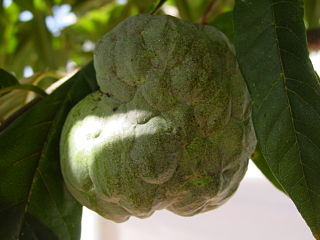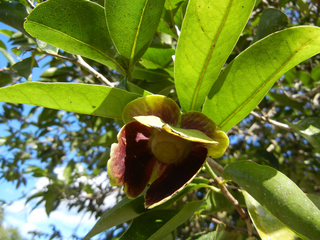
The Annonaceae are a family of flowering plants consisting of trees, shrubs, or rarely lianas commonly known as the custard apple family or soursop family. With 108 accepted genera and about 2400 known species, it is the largest family in the Magnoliales. Several genera produce edible fruit, most notably Annona, Anonidium, Asimina, Rollinia, and Uvaria. Its type genus is Annona. The family is concentrated in the tropics, with few species found in temperate regions. About 900 species are Neotropical, 450 are Afrotropical, and the remaining are Indomalayan.

Anaxagorea is a genus of flowering plants in the subfamily Anaxagoreoideae in the family Annonaceae. There are about 26 species, distributed in Central and South America.
Boutiquea is a monotypic genus of flowering plants in the family Annonaceae containing the single species Boutiquea platypetala. It is native to Cameroon and Equatorial Guinea.
Hexalobus mossambicensis is a species of plant in the Annonaceae family. It is endemic to Mozambique.
Hexalobus is a genus of flowering plants in the family Annonaceae. There are five species native to tropical Africa.
Hexalobus salicifolius is a species of flowering plant in the family Annonaceae. It is found in Cameroon, Ivory Coast, Gabon, and the Republic of the Congo. Local common names include oouè, owoé, and owui.
Klarobelia lucida is a species of plant in the Annonaceae family. It is endemic to Ecuador. Its natural habitat is subtropical or tropical dry forests. It is threatened by habitat loss.

Klarobelia megalocarpa is a species of flowering plants in the family Annonaceae. It is endemic to Ecuador. Its natural habitat is subtropical or tropical moist lowland forests. It is threatened by habitat loss.

Mosannona is a genus of flowering plants in the family Annonaceae. There are about 14 species native to the Neotropics, distributed from Mexico through Central America and South America particularly in rainforest surrounding the Andes.
Duguetia tobagensis is a small tree in the plant family Annonaceae which is endemic to Trinidad and Tobago. The species is only known from Tobago.

Duguetia is a genus of trees and shrubs in the plant family Annonaceae with approximately 90 species in central and South America, and four species in west Africa.

Cremastosperma is a genus of flowering plants in the family Annonaceae, subfamily Malmeoideae, tribe Malmeae. In 2018 there were 34 recognised species distributed in Central and South America.

Cremastosperma yamayakatense is a species of tropical tree in the "soursop" family Annonaceae that is found in lowland rainforest in the Amazonas Region of northern Peru.

Cremastosperma cauliflorum is a species of plant in the family Annonaceae. It is native to Brazil, Colombia, Ecuador and Peru. Robert Elias Fries, the Swedish botanist who first formally described the species, named it after its flowers which grow from its main trunk or stem.
Fusaea peruviana is a species of plant in the family Annonaceae. It is native to Brazil, Colombia, Ecuador and Peru. Robert Elias Fries, the Swedish botanist who first formally described the species, named it after Peru where the specimen he examined was found near the Huallaga River and the city of Yurimaguas.
Hexalobus bussei is a species of plant in the family Annonaceae. It is native to Cameroon. Ludwig Diels, the German botanist who first formally described the species, named it after another German botanist, Walter Busse, who collected the sample that Diels examined.

Huberantha is a genus of plants in the family Annonaceae and tribe Miliuseae. It is distributed in Australia, tropical Asia, East Africa and some Pacific islands. Tanawat Chaowasku named the genus "Huber's flowers" in honor of the German botanist Herbert Huber and to highlight its flowers as a distinguishing feature of the genus. A number of species have been moved here from the genus Polyalthia.

Mosannona depressa is an evergreen tree within the Annonaceae family native to tropical southern Mexico, Belize, Guatemala, and Honduras.

Friesodielsia is a genus of flowering plants in the custard apple and soursop family Annonaceae, with all species found in the Old World, mostly in the tropics. A molecular study shows that Friesodielsia should be more narrowly circumscribed, with the only species remaining being the Asian ones, which can also be distinguished by their possession of globose or ellipsoid monocarps, and six petals per flower arranged in two whorls.
Afroguatteria is a small genus of flowering plants in the family Annonaceae, native to Cabinda and Zaire. Climbers, they are closely related to Toussaintia.










